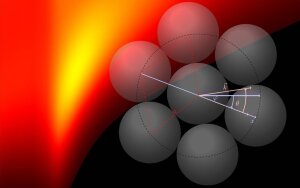Optical properties of hybrid nanostructures
Optische Eigenschaften hybrider Nanostrukturen
Image: Ulf PeschelOptical properties of hybrid nanostructures
The junior research group investigates nanostructured devices for spectroscopy, microscopy, photovoltaics and catalysis. The fundamental optical response of plasmonic and dielectric systems is considered from a classical electromagnetic perspective, including properties of amorphous materials, rough interfaces, nonlinear and semi-classical interactions. The aim is to realistically describe complex nanoparticle distributions and ultrathin multilayers with reliable and rapid methods of computational nanophotonics while extending its scope towards multiphysics aspects.
Nonlinear and non-classical properties of amorphous Iridium heterostructures as well as mutlilayers are investigated within the CRC 1375 NOA "Nonlinear optics down to atomic scales" together with experimental groups at the Institute of Applied Physics. Hereby, we develop and implement analytical models and numerical methods for a realistic description of the experimental situation.
With respect to multiphysics processes, we are interested in soft plasmonics, where charge interactions in ionic systems are studied in analogy to plasmons in solid metals. This can be used to describe, e.g. electrolytes or biological systems, such as nerve cell signaling.
- C. David, "TiO2 Self-Assembled, Thin-Walled Nanotube Arrays for Photonic Applications", Materials 12(8), 1332 (2019)
- W. Jacak, "On Modeling of Plasmon-Induced Enhancement of the Efficiency of Solar Cells Modified by Metallic Nano-Particles", Nanomaterials 9(1), 3 (2019)
- C. David, "Two-fluid, hydrodynamic model for spherical electrolyte systems", Scientific Reports, 8, 7544 (2018).
- H. Öner, C. J. Querebillo, C. David, U. Gernert, C. Walter, M. Driess, S. Leimkühler, K. H. Ly, I. M. Weidinger, "High electromagnetic field enhancement of TiO2 nanotubes electrodes", Angewandte Chemie International Edition, 57, 7225–7229 (2018)
- C. David, J. Christensen, und N. A. Mortensen, "Spatial dispersion in 2D plasmonic crystals: Large blueshifts promoted by diffraction anomalies", Phys. Rev. B 94, 165410 (2016).
